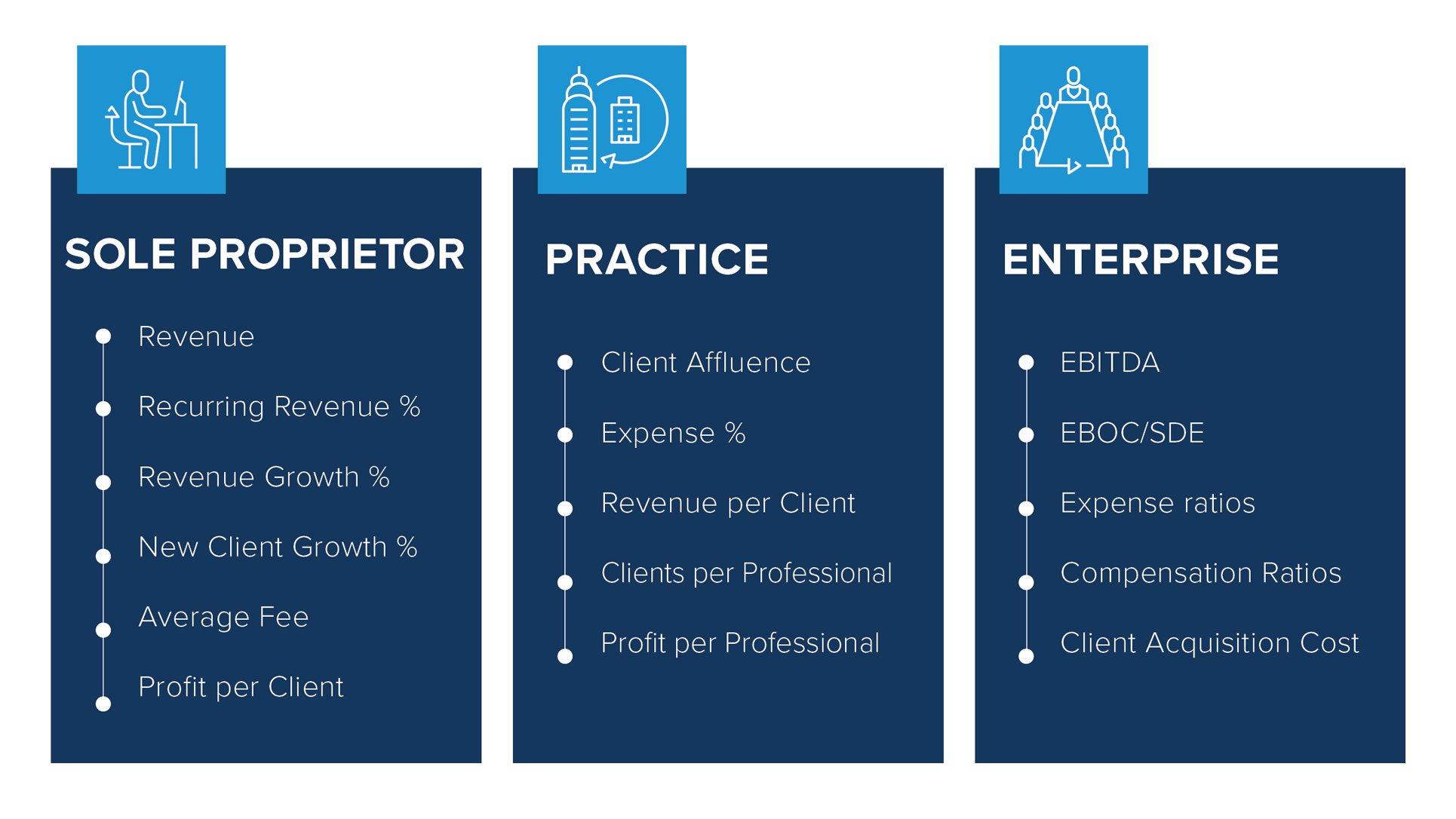Blog
Mark, Measure, Monitor and Master KPIs to Maximize Growth, Profit, and Value

Key performance indicators, or KPIs, are data points which help businesses assess progress towards an intended result. Ensuring you take the time to Mark, Measure, Monitor, and Master those KPIs which will help you manage, protect, and grow the equity value of your business.
Step One: Mark various data points and establish a baseline.
Running your business well and optimizing your equity value starts with an annual valuation of your business. With the data gathered in this process we can track relevant metrics and establish an understanding of the current leading and lagging indicators of success in your business.
The most relevant KPIs can be divided into Revenue strength and Enterprise Strength KPIs.
Revenue Strength is the principal component in determining the value of a privately held financial services practice. At its most basic level, value lies in household relationships and the revenue stream they generate. As such, the term "revenue strength" refers to the strength and durability of the revenue sources and profit centers of an advisory practice. Primary examples of revenue strength KPIs include: recurring revenue percentage, average revenue growth rate, and revenue per client.
Enterprise Strength is the measurement of your physical and organizational structure which supports not only growth, but the enduring value of the practice. We’re addressing the questions: Are the necessary resources and people in place? Is your team adequately and properly compensated in a way that sustains efficient and competitive growth rates well into the future?
We can think of enterprise strength factors as the engine for creating and supporting the revenue strength elements. Without enterprise strength it's near impossible to achieve sustained growth and long-term value appreciation. Examples of enterprise strength KPIs include; pay per employee, clients per professional, and profit per owner.
It's important to note relevant KPIs change as a business evolves. For example, a sole proprietor might start by tracking their average fee charged. As it grows into a practice, revenue per client becomes a more important metric. By the time it becomes an enterprise, EBIDA and compensation ratios emerge as more common KPIs.

Regardless of stage of your firm, a relatively universal guiding principle is a rule of thirds. One third of your revenue should be allocated to professional compensation. One third should account for all other overhead–which would include non-revenue producing comp, occupancy, technology, and marketing. This leaves one third for profits, which are usually paid out in quarterly distributions.
Step Two: Measure against similar businesses.
Next, it’s important to give these marked KPIs context and a point of reference from which to compare them. Benchmarking a businesses KPIs with peers of the same valuation allows you to determine the quality of your business’s growth and to identify areas of strength and improvement.
Pinpointing opportunities for enhancement can be more valuable than discovering areas of excellence. These are the insights that will allow you to boost growth and value, as well as develop an idea of what your metrics might be a few years down the road.
Exploring KPIs as a whole creates a complete picture of your business and allows us to see how different factors are affecting each other, and how things will change as you continue to work on the business.
In the video below, Scott Leak breaks down a KPI case study to illustrate how a business can outperform its peers in some areas while trailing in others. Additionally, he highlights how the performance of these metrics provide an opportunity for increased capacity and AUM.
Step Three: Monitor your KPIs at regular intervals.
Managing equity in a financial services practice is an ongoing process. Just as you do annual reviews for your clients and their financial plans and investment portfolios, you want to do the same for the KPIs in your business. KPI assessments should be made at least annually to provide an accurate picture of growth and to set a comprehensive improvement plan.
When you leverage a library of annual valuations and benchmarking reports, you can see trends emerge and identify how your strengths and areas of improvement evolve. The comprehensive picture your annual reports present can make your business more attractive to prospective clients, next-generation talent, future owners, and even potential sellers of other advisory businesses who want their clients cared for by a well-run organization.
Step Four: Master your KPIs to help manage, protect, and improve your business.
Understanding how your KPIs align with your unique business goals allows you to make strategic decisions about your business. This allows you to know how to push each metric and when to maximize growth, profit, and value.
Every year, after generating an annual valuation and benchmarking report, our qualified consultants help hundreds of your industry peers take action to master their KPIs most relevant to their unique businesses with continuous guidance. Consider the membership services of our Equity Management Solutions™ to help you Mark, Measure, Monitor and Master the KPIs driving the equity value in your business.
Learn more about KPIs and which are appropriate for your business in our webinar, "Key Performance Indicators of Running a Successful Business." Watch now.
